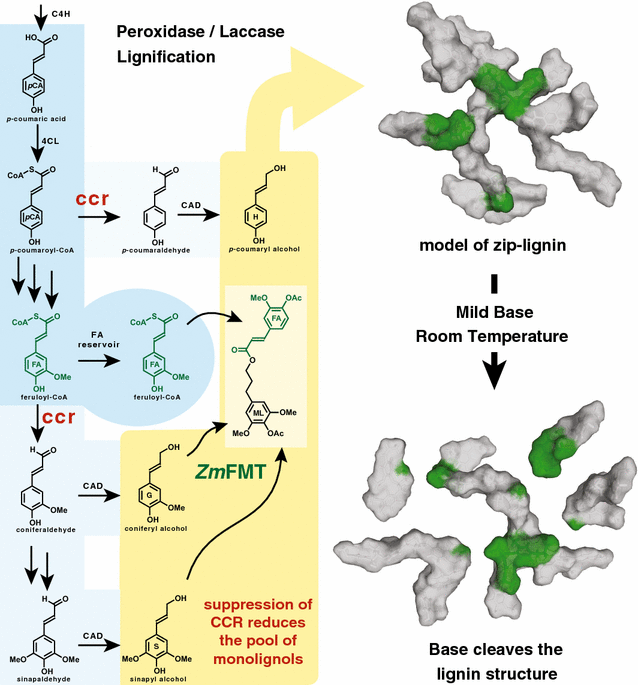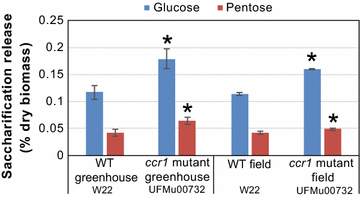Suppression of CINNAMOYL- CoA REDUCTASE increases the level of monolignol ferulates incorporated into maize lignins
- PMID: 28469705
- PMCID: PMC5414125
- DOI: 10.1186/s13068-017-0793-1
Suppression of CINNAMOYL- CoA REDUCTASE increases the level of monolignol ferulates incorporated into maize lignins
Abstract
Background: The cell wall polymer lignin provides structural support and rigidity to plant cell walls, and therefore to the plant body. However, the recalcitrance associated with lignin impedes the extraction of polysaccharides from the cell wall to make plant-based biofuels and biomaterials. The cell wall digestibility can be improved by introducing labile ester bonds into the lignin backbone that can be easily broken under mild base treatment at room temperature. The FERULOYL-CoA MONOLIGNOL TRANSFERASE (FMT) enzyme, which may be naturally found in many plants, uses feruloyl-CoA and monolignols to synthesize the ester-linked monolignol ferulate conjugates. A mutation in the first lignin-specific biosynthetic enzyme, CINNAMOYL-CoA REDUCTASE (CCR), results in an increase in the intracellular pool of feruloyl-CoA.
Results: Maize (Zea mays) has a native putative FMT enzyme, and its ccr mutants produce an increased pool of feruloyl-CoA that can be used for conversion to monolignol ferulate conjugates. The decreased lignin content and monomers did not, however, impact the plant growth or biomass. The increase in monolignol conjugates correlated with an improvement in the digestibility of maize stem rind tissue.
Conclusions: Together, increased monolignol ferulates and improved digestibility in ccr1 mutant plants suggests that they may be superior biofuel crops.
Keywords: Biofuels; Cell wall digestibility; Mass spectrometry; Zea mays.
Figures




Similar articles
-
Manipulation of Lignin Monomer Composition Combined with the Introduction of Monolignol Conjugate Biosynthesis Leads to Synergistic Changes in Lignin Structure.Plant Cell Physiol. 2022 Jun 15;63(6):744-754. doi: 10.1093/pcp/pcac031. Plant Cell Physiol. 2022. PMID: 35275214 Free PMC article.
-
Trends in lignin modification: a comprehensive analysis of the effects of genetic manipulations/mutations on lignification and vascular integrity.Phytochemistry. 2002 Oct;61(3):221-94. doi: 10.1016/s0031-9422(02)00211-x. Phytochemistry. 2002. PMID: 12359514 Review.
-
Stacking AsFMT overexpression with BdPMT loss of function enhances monolignol ferulate production in Brachypodium distachyon.Plant Biotechnol J. 2021 Sep;19(9):1878-1886. doi: 10.1111/pbi.13606. Epub 2021 May 15. Plant Biotechnol J. 2021. PMID: 33949064 Free PMC article.
-
Structural Redesigning Arabidopsis Lignins into Alkali-Soluble Lignins through the Expression of p-Coumaroyl-CoA:Monolignol Transferase PMT.Plant Physiol. 2016 Mar;170(3):1358-66. doi: 10.1104/pp.15.01877. Epub 2016 Jan 29. Plant Physiol. 2016. PMID: 26826222 Free PMC article.
-
Modifying crops to increase cell wall digestibility.Plant Sci. 2012 Apr;185-186:65-77. doi: 10.1016/j.plantsci.2011.10.014. Epub 2011 Oct 25. Plant Sci. 2012. PMID: 22325867 Review.
Cited by
-
The lignin toolbox of the model grass Setaria viridis.Plant Mol Biol. 2019 Oct;101(3):235-255. doi: 10.1007/s11103-019-00897-9. Epub 2019 Jun 28. Plant Mol Biol. 2019. PMID: 31254267
-
The caffeoyl-CoA O-methyltransferase gene SNP replacement in Russet Burbank potato variety enhances late blight resistance through cell wall reinforcement.Plant Cell Rep. 2021 Jan;40(1):237-254. doi: 10.1007/s00299-020-02629-6. Epub 2020 Nov 3. Plant Cell Rep. 2021. PMID: 33141312
-
Construction of the SHP-GLOX lignin regulation system and its application in rice straw.Plant Methods. 2022 Jun 18;18(1):85. doi: 10.1186/s13007-022-00917-8. Plant Methods. 2022. PMID: 35717235 Free PMC article.
-
Genome-wide association analysis of stalk biomass and anatomical traits in maize.BMC Plant Biol. 2019 Jan 31;19(1):45. doi: 10.1186/s12870-019-1653-x. BMC Plant Biol. 2019. PMID: 30704393 Free PMC article.
-
Highly differentiated genomic properties underpin the different cell walls of Poaceae and eudicots.Plant Physiol. 2023 Dec 30;194(1):274-295. doi: 10.1093/plphys/kiad267. Plant Physiol. 2023. PMID: 37141316 Free PMC article.
References
-
- Miksche GE. Lignin reactions in alkaline pulping processes (rate processes in soda pulping) In: Nakano J, Singh RP, editors. Chemistry of delignification with oxygen, ozone, and peroxides. Tokyo: Uni Publishers Co.; 1980. pp. 107–120.
LinkOut - more resources
Full Text Sources
Other Literature Sources

